Indian jewelry is a mesmerizing blend of tradition, culture, and artistry, embodying the rich heritage and diverse craftsmanship of India. From the intricate designs of the North to the vibrant styles of the South, each piece tells a story of its own, reflecting the identity and the age-old traditions of the region it hails from. This blog explores the myriad types of Indian jewelry, delving into their origins, significance, and the artistry that makes them unique.
Table of Contents
Introduction to Indian Jewelry
Indian jewelry is not just an accessory; it’s a cultural symbol, a testament to the craftsmanship that has been passed down through generations. It plays a crucial role in the life of an Indian woman, marking significant milestones from birth to marriage and beyond. The diversity in Indian jewelry is vast, owing to the country’s rich tapestry of cultures, each region boasting its own distinct style and technique.
Traditional Types of Indian Jewelry
1 . Kundan Jewelry:
Originating from the royal courts of Rajasthan and Gujarat, Kundan jewelry is renowned for its intricate designs and use of pure gold. The process involves meticulously setting precisely cut and shaped gemstones into gold, characterized by its detailed craftsmanship and radiant polish. A quintessential element of Indian weddings, Kundan jewelry’s timeless appeal makes it a treasured possession.
2. Polki Jewelry:
Polki jewelry employs uncut diamonds as the primary stone, set in gold, distinguishing it from Kundan. Introduced by the Mughals, it symbolizes royalty and opulence. Polki pieces, with their natural, unrefined beauty, are often heirlooms, valued for their authentic, rustic appearance.
3. Meenakari Jewelry:
Meenakari, the art of coloring and ornamenting the surface of metals by fusing brilliant colors in intricate designs, originated in the Mughal era. Predominantly flourishing in Rajasthan, it is often used alongside Kundan to add vibrant hues to gold jewelry. This technique brings to life the metal’s surface with detailed, colorful patterns.
4. Temple Jewelry:
Originally crafted to adorn deities in temples, Temple jewelry from South India is notable for its divine motifs, including gods, goddesses, and sacred animals, all intricately fashioned in gold. Today, it graces bridal attire, adding a touch of sanctity and tradition to weddings.
5. Jadau Jewelry:
Introduced by the Mughals, Jadau jewelry involves embedding precious and semi-precious stones into heated gold, which then solidifies to secure the stones in place. Known for its heavy, ornate designs, Jadau jewelry is favored for special occasions.
6. Thewa Jewelry:
Thewa is a unique art form from Rajasthan, where intricate designs are engraved on gold sheets which are then fused onto glass, creating a translucent effect. This technique produces stunning pieces that blend the rich colors of the glass with the luster of gold, often depicting historical or mythological scenes.
7. Navratna Jewelry:
Navratna, meaning ‘nine gems,’ represents the celestial significance of nine gemstones, each corresponding to a celestial being in Hindu astrology. This jewelry type harmoniously combines these gems in a single setting, believed to bring good luck and protection to the wearer. Navratna jewelry is popular for its astrological significance as well as its aesthetic appeal.
8. Silver Tribal Jewelry:
Tribal jewelry, made predominantly from silver, is distinguished by its bold, rustic designs. Originating from the tribal regions of India, such as Rajasthan, Gujarat, and the Northeast, this jewelry type is characterized by its geometric patterns and motifs inspired by nature. It is not only a reflection of India’s tribal cultures but also a statement piece in contemporary fashion.
9. Gold Jewelry:
Gold jewelry holds a paramount place in Indian culture, symbolizing wealth, prosperity, and status. Indian gold jewelry ranges from heavy, intricate bridal sets to more delicate, everyday wear pieces. The designs vary widely across regions, with South Indian jewelry known for its temple-based motifs and North Indian jewelry celebrated for its intricate filigree and meenakari work.
Regional Variations in Indian Jewellery
- Filigree Jewelry in Odisha and West Bengal
Filigree work, or ‘Tarakasi’, is a sophisticated form of metalwork involving gold and silver, creating intricate designs using tiny beads or twisted threads. This technique is prevalent in Cuttack, Odisha, and parts of West Bengal, celebrated for its delicate artistry and elegant motifs.
2. Lac Jewelry of Rajasthan:
Lac, or Lacquer jewelry, involves embedding brightly colored lacquer within silver or gold frames, creating vibrant and eye-catching pieces. This form of jewelry is particularly popular in Rajasthan, known for its vivid colors and affordability, with Lac bangles being an essential accessory for many women.
3. Pachchikam Jewelry:
Originating from Gujarat, Pachchikam jewelry is known for its rustic and antique appearance, resembling Kundan but with a less polished finish. This style is valued for its vintage charm and detailed craftsmanship, enjoying a resurgence in popularity for those seeking traditional yet distinctive pieces.
4. Guttapusalu Jewelry of Andhra Pradesh:
Guttapusalu, originating from the coastal regions of Andhra Pradesh, is a type of necklace characterized by its heavy clusters of pearls and gold charms that resemble a shoal of small fish, hence its name. Often embellished with rubies, emeralds, and other precious stones, Guttapusalu necklaces are a testament to the lavish use of pearls in Indian jewelry.
5. Kashmiri Jewelry:
Kashmiri jewelry is known for its intricate work and the use of precious stones and pearls. The traditional ‘Dejhoor’, worn by Kashmiri Pandit women, is a unique ear ornament that hangs from the earlobe and is passed through a gold chain worn around the ears and head. This piece is symbolic of a woman’s marital status in Kashmiri culture.
6. Kolhapuri Saaj from Maharashtra:
The Kolhapuri Saaj is a traditional Maharashtrian necklace, significant for its unique design and cultural value. It consists of beads and a pendant that depicts various forms of Lord Vishnu. Made of gold, the Saaj is an integral part of the bridal trousseau in Maharashtra, symbolizing prosperity and happiness.
7. Naga Jewelry from Northeast India:
Naga jewelry, from the tribes of Nagaland, stands out for its bold designs and use of organic materials such as bone, wood, shells, and beads. This type of jewelry is deeply rooted in the tribal culture and traditions of the Nagas, reflecting their connection with nature and the warrior spirit.
8. Thushi Necklaces from Maharashtra
Thushi necklaces are a type of choker made with closely set gold beads on a fine gold chain, originating from Maharashtra. Known for its simplicity and elegance, Thushi necklaces are often worn by brides and are a staple in Maharashtrian jewelry.
9. Silver Jewelry of Himachal Pradesh:
In the hilly terrains of Himachal Pradesh, silver jewelry is predominant, with designs that are robust and symbolic. The traditional ornaments include large, ornate nose rings, earrings, and necklaces that often carry religious and cultural significance, reflecting the state’s tribal heritage.
10. Hyderabadi Jewelry:
Hyderabadi jewelry is renowned for its exquisite craftsmanship and unique designs, deeply rooted in the city’s regal heritage that dates back to the Nizam era. This style of jewelry is characterized by its use of diamonds, pearls, and precious stones set in intricate patterns, often showcasing a blend of Mughal and traditional South Indian influences.
Contemporary Trends in Indian Jewelry
While traditional jewelry of India continues to hold a special place in the hearts of Indian women, contemporary designs that blend traditional techniques with modern aesthetics are gaining popularity. Designers are experimenting with materials, designs, and techniques to create jewelry that caters to the modern woman while still retaining the essence of traditional Indian jewelry.
The Cultural Significance and Global Influence
Indian jewelry is much more than an accessory; it’s an expression of identity, a symbol of status, and a bearer of cultural significance. It has influenced global fashion trends, with international designers drawing inspiration from the intricate designs and techniques of Indian jewelry-making. Indian jewelry has thus not only preserved its traditional roots but has also embraced modernity, making it relevant in the contemporary world.
Final Words:
The diverse types of Indian jewelry are a testament to the country’s rich cultural heritage and the unparalleled skills of its artisans. From the royal Kundan and Polki to the divine Temple jewelry and the rustic Pachchikam, each piece carries with it a story, a tradition, and a piece of Indian culture. As the world becomes increasingly globalized, the unique charm and intricate craftsmanship of Indian jewelry continue to captivate and inspire, making it a cherished treasure not just in India, but around the world.
This exploration of Indian jewelry not only highlights the vast array of types available but also underscores the deep-rooted cultural significance and the meticulous artistry that goes into creating each piece. As trends evolve, the essence of Indian jewelry remains unchanged, continuing to enchant with its beauty, intricacy, and cultural depth.
FAQs:
- What are the categories of Indian jewellery?
Indian jewelry can broadly be categorized based on its geographical origins, materials used, and the techniques applied in its creation. Major categories include:
- Traditional Jewelry: Encompasses region-specific jewelry like Kundan (Rajasthan), Meenakari (Rajasthan), Pachchikam (Gujarat), and Temple jewelry (South India).
- Tribal or Ethnic Jewelry: Includes pieces like the silver ornaments of the tribes of Northeast India, and the beadwork and metal jewelry of the tribal populations of Central India.
- Contemporary Jewelry: Modern designs that blend traditional Indian motifs with global trends, often lighter and suited for daily wear.
- Bridal Jewelry: Elaborate sets that are typically worn by Indian brides, encompassing necklaces, earrings, bangles, and more, usually in gold, often enriched with precious stones.
- Religious Jewelry: Items that hold spiritual significance, such as chooda, pendants, rings, or bracelets featuring religious symbols or deities.
- Gemstone Jewelry: Includes jewelry made with precious and semi-precious stones, often associated with astrological beliefs.
- Gold Jewelry: Given its cultural significance and investment value, gold jewelry forms its own category and is widely preferred for weddings and festivals.
2. Which type of jewelry is famous in India?
Kundan and Polki jewelry are among the most famous types of jewelry in India, known for their intricate craftsmanship and royal look. Gold jewelry, given its cultural significance and timeless appeal, is also extremely popular across the country. Additionally, Meenakari work from Rajasthan, Temple jewelry from South India, and tribal jewelry from the Northeastern states hold a special place for their unique designs and cultural importance.
3. How many types of jewellery are there?
Indian jewellery encompasses a rich tapestry of adornments, each bearing cultural significance and intricate craftsmanship. From the iconic jhumkas dangling delicately from earlobes to the majestic necklaces gracing the neckline, every piece tells a story of tradition and elegance. Anklets, or payals, infuse every step with musical charm, while bangles adorn wrists with a melodic jingle. The maang tikka adorns foreheads with grace, while nose rings, or naths, add a touch of cultural heritage. Toe rings, known as bichua, and the sacred mangalsutra symbolize marital bliss and commitment. Together, these jewellery types form a vibrant mosaic of India’s rich cultural heritage, embodying beauty, tradition, and timeless elegance.
4. What jewelry is worn by Indian?
Indian men and women wear a wide range of jewelry, often selected based on the occasion, regional culture, and personal preference. Commonly worn jewelry includes:
- Necklaces and Chains: Ranging from heavy, ornate pieces for brides to simple gold chains for daily wear.
- Earrings: Including jhumkas (bell-shaped earrings), studs, and drop earrings.
- Bangles and Bracelets: Gold bangles are particularly popular, as are glass bangles in certain regions.
- Rings: Worn by both men and women, often featuring precious stones.
- Anklets and Toe Rings: Commonly worn by women, with anklets often made of silver.
- Maang Tikka and Head Ornaments: Worn on the forehead, particularly by brides.
- Waist Belts (Kamarband): Ornate belts worn around the waist, especially in bridal attire.
- Armlets (Bajuband): Worn on the upper arm, often in weddings and traditional dances.
Jewelry plays a significant role in Indian culture, symbolizing status, wealth, and aesthetic preferences, and is an integral part of both everyday attire and special occasions.
5. Which type of jewellery is preferred in Indian wedding days?
On Indian wedding days, brides and grooms prefer traditional and elaborate jewelry that signifies cultural heritage and personal style. The type of jewelry can vary significantly depending on regional and familial traditions. Commonly preferred types include:
- Gold Jewelry: Universally revered in Indian weddings for its auspicious significance and as a symbol of wealth and prosperity.
- Kundan Jewelry: Known for its intricate craftsmanship, Kundan jewelry is a popular choice for its royal and timeless appeal.
- Polki Jewelry: Valued for its natural, uncut diamonds set in gold, offering a vintage and luxurious look.
- Temple Jewelry: Preferred in South Indian weddings, this type features designs of gods, goddesses, and sacred symbols in gold, signifying blessings for the newlyweds.
- Jadau Jewelry: Favored for its heavy and ornate designs, incorporating precious stones embedded in gold through a unique technique.
6. What jewelry do Indian brides wear?
Indian brides adorn themselves with a variety of jewelry, which not only enhances their beauty but also carries cultural and symbolic meanings. A typical bridal jewelry set may include:
- Mangalsutra: A sacred necklace worn by married women as a symbol of matrimonial commitment.
- Necklaces: Heavy chokers, long chains, and layered necklaces in gold or with precious stones.
- Earrings: Large, intricate designs like Jhumkas or Chandbalis that complement the bridal attire.
- Maang Tikka or Matha Patti: Worn on the forehead, symbolizing the third eye.
- Nath (Nose Ring): A traditional nose ring, often connected to the earring by a chain.
- Bangles and Bracelets: Sets of gold bangles, or a combination of glass and gold, along with intricate bracelets.
- Armlets (Bajuband): Worn on the upper arm to add elegance to the bridal look.
- Waist Belt (Kamarband): Accentuates the waistline and helps to manage the trending sarees or lehenga.
- Anklets and Toe Rings: Usually made of silver, signifying marital status and adding charm to the bride’s feet.
7. What was the significance of South Indian jewelry, and why do women like to wear jewelry? What kind of jewellery would be worn by them?
South Indian jewelry is deeply rooted in the region’s rich traditions, religious beliefs, and cultural heritage. It is significant for several reasons:
- Cultural Identity: Jewelry in South India is often passed down through generations as family heirlooms, serving as a symbol of familial pride and continuity.
- Aesthetic Appeal: The intricate designs and craftsmanship of South Indian jewelry enhance the beauty and grace of the wearer, making it a favored accessory for women.
- Religious Significance: Many pieces, especially temple jewelry, have motifs of gods and goddesses, believed to bestow blessings upon the wearer.
- Social Status: Jewelry in South India is also a marker of social and economic status, with more elaborate and heavy pieces worn by those of higher social standing.
South Indian women wear a variety of jewelry, including:
- Temple Jewelry: Necklaces, earrings, and bangles featuring motifs of deities, widely worn for religious ceremonies and weddings.
- Kasu Mala (Coin Necklace): A traditional necklace made of gold coins, a staple in bridal attire.
- Manga Mala (Mango Necklace): Necklaces with mango-shaped motifs, symbolizing fertility and prosperity.
- Oddiyanam (Waist Belt): A gold waist belt that is both ornamental and functional, holding the saree in place.
- Vanki (Armlet): A uniquely designed armlet that narrows towards the elbow, often depicting serpents or peacocks.
- Jhumkas: Bell-shaped earrings that are essential to South Indian jewelry collections.
Women in South India, like elsewhere, wear jewelry for its beauty, to uphold tradition, and to signify their marital status, among other reasons. The choice of jewelry often reflects personal tastes, familial traditions, and the significance of the occasion.



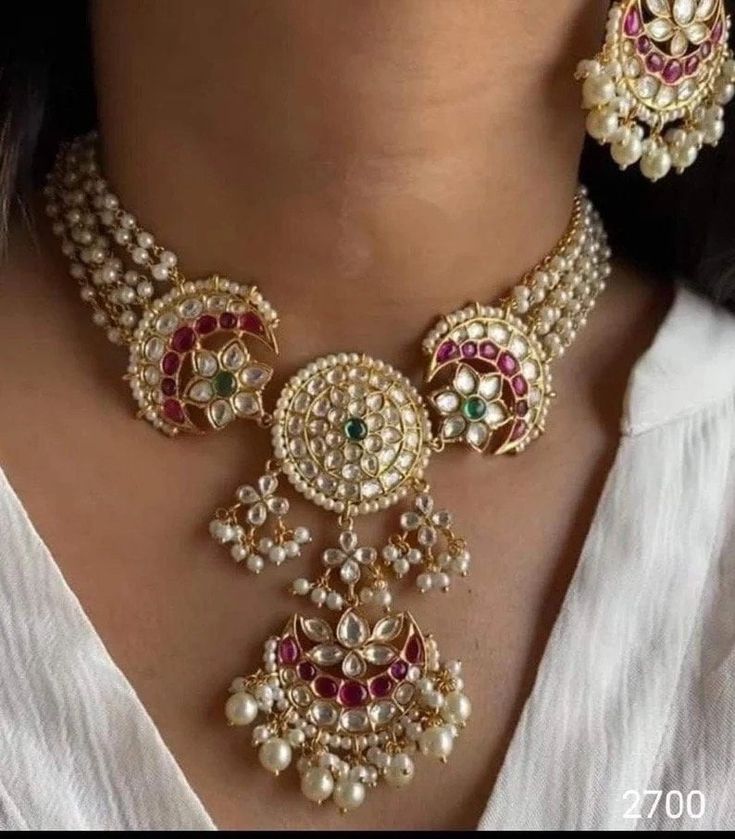
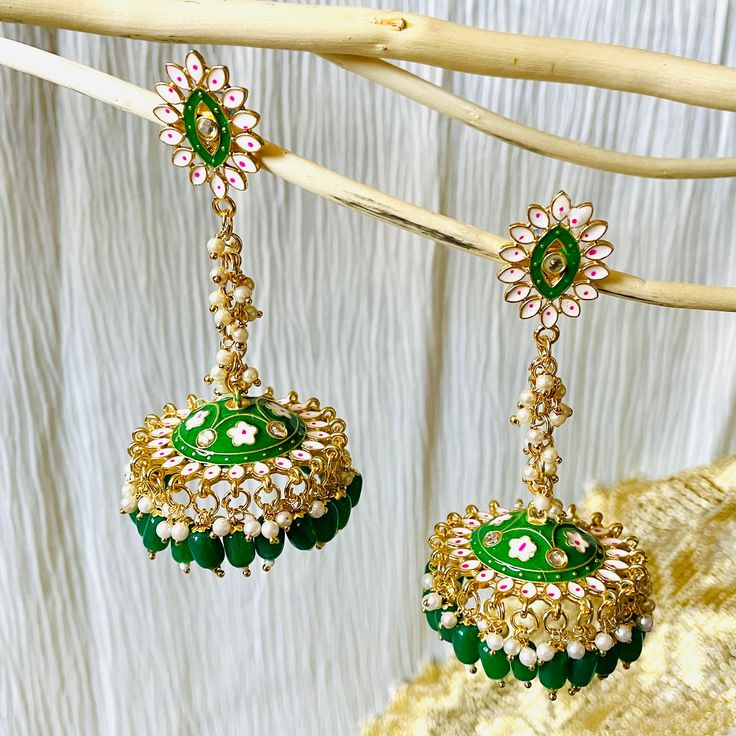


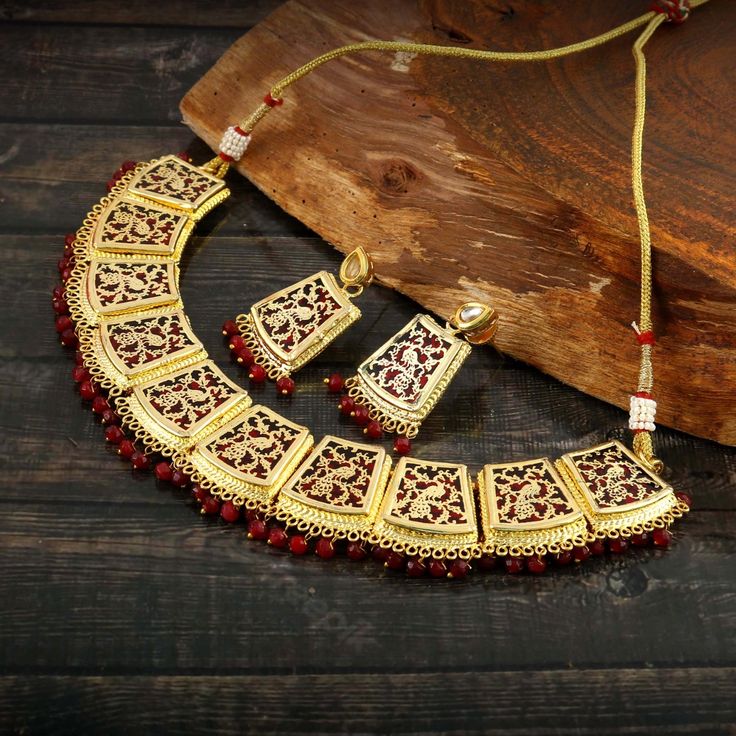




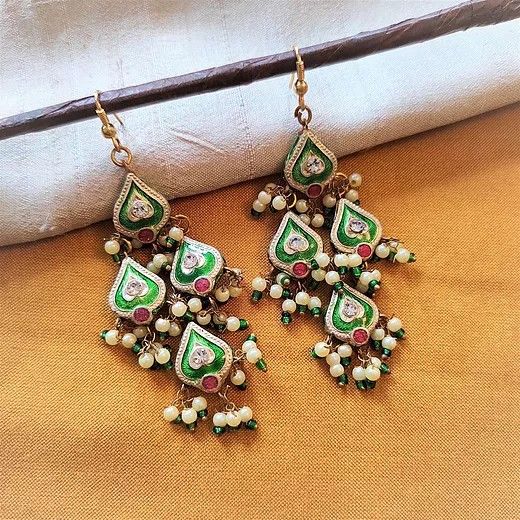


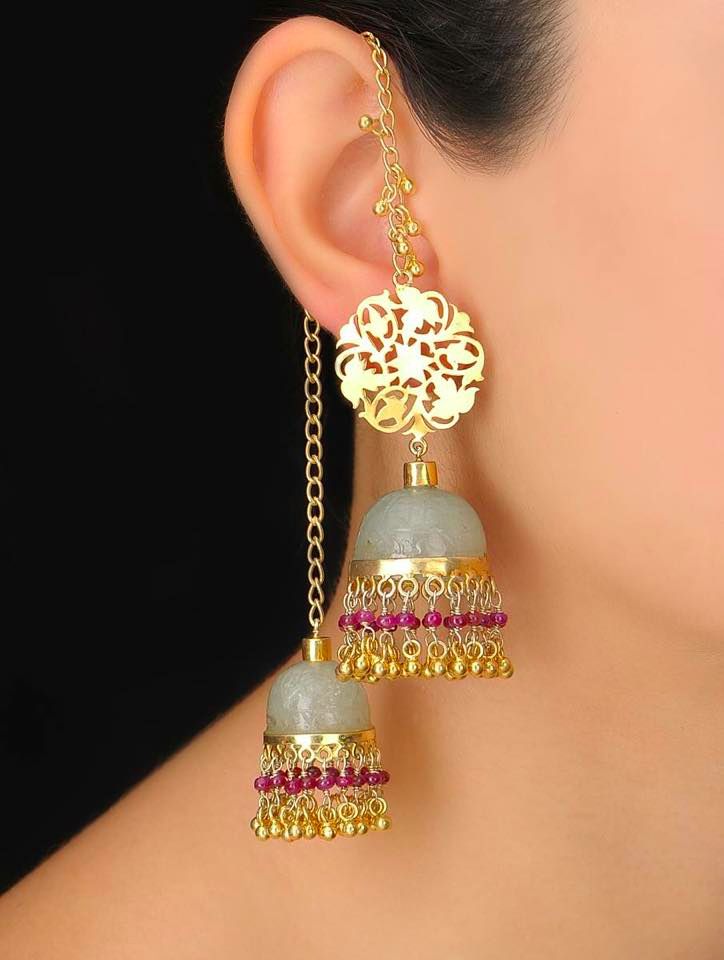













1 thought on “Types of Indian Jewellery: Exploring Cultural Adornments”